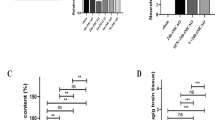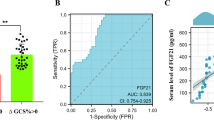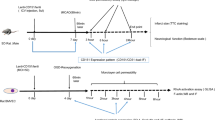Abstract
Cerebral ischemia/reperfusion (I/R) injury increases blood-brain barrier (BBB) permeability, leading to hemorrhagic transformation and brain edema. Normobaric oxygen (NBO) is a routine clinical treatment strategy for this condition. However, its neuroprotective effects remain controversial. This study investigated the effect of different NBO concentrations on I/R injury and explores the involvement of the nuclear factor erythroid 2-related factor 2 (Nrf2) pathway in the underlying mechanism. A mouse middle cerebral artery occlusion (MCAO) model, and an oxygen and glucose deprivation (OGD) model featuring mouse brain microvascular endothelial cells (ECs) called bEnd.3, were used to investigate the effect of NBO on I/R injury. A reactive oxygen species (ROS) inducer and Nrf2-knockdown by RNA were used to explore whether the Nrf2 pathway mediates the effect of NBO on cerebrovascular ECs. In the early stage of MCAO, 40% O2 NBO exposure significantly improved blood perfusion in the ischemic area and effectively relieved BBB permeability, cerebral edema, cerebral injury, and neurological function after MCAO. In the OGD model, 40% O2 NBO exposure significantly reduced apoptosis, inhibited ROS generation, reduced ER stress, upregulated the expression of tight junction proteins, and stabilized the permeability of ECs. Blocking the Nrf2 pathway nullified the protective effect of 40% O2 NBO on ECs after OGD. Finally, our study confirmed that low concentrations of NBO have a neuroprotective effect on I/R by activating the Nrf2 pathway in ECs.




Similar content being viewed by others
Data Availability
All original data will be made available on reasonable request to Zhen-Hong Wang.
References
Collaborators GBDCD (2018) Global, regional, and national age-sex-specific mortality for 282 causes of death in 195 countries and territories, 1980–2017: a systematic analysis for the global burden of Disease Study 2017. Lancet 392(10159):1736–1788. https://doi.org/10.1016/S0140-6736(18)32203-7
Safety and efficacy of fluoxetine on functional recovery after acute stroke (EFFECTS) : A randomised, double-blind, placebo-controlled trial (2020). Lancet Neurol 19 (8):661–669. https://doi.org/10.1016/s1474-4422(20)30219-2
Jauch EC, Saver JL, Adams HP Jr., Bruno A, Connors JJ, Demaerschalk BM, Khatri P, McMullan PW Jr., Qureshi AI, Rosenfield K, Scott PA, Summers DR, Wang DZ, Wintermark M, Yonas H, American Heart Association Stroke C, Council on Cardiovascular N, Council on Peripheral Vascular D, Council on Clinical C (2013) Guidelines for the early management of patients with acute ischemic Stroke: a guideline for healthcare professionals from the American Heart Association/American Stroke Association. Stroke 44(3):870–947. https://doi.org/10.1161/STR.0b013e318284056a
Kobayashi A, Czlonkowska A, Ford GA, Fonseca AC, Luijckx GJ, Korv J, de la Ossa NP, Price C, Russell D, Tsiskaridze A, Messmer-Wullen M, De Keyser J (2018) European Academy of Neurology and European Stroke Organization consensus statement and practical guidance for pre-hospital management of Stroke. Eur J Neurol 25(3):425–433. https://doi.org/10.1111/ene.13539
Powers WJ, Rabinstein AA, Ackerson T, Adeoye OM, Bambakidis NC, Becker K, Biller J, Brown M, Demaerschalk BM, Hoh B, Jauch EC, Kidwell CS, Leslie-Mazwi TM, Ovbiagele B, Scott PA, Sheth KN, Southerland AM, Summers DV, Tirschwell DL, American Heart Association Stroke C (2018) 2018 guidelines for the early management of patients with Acute ischemic Stroke: a Guideline for Healthcare professionals from the American Heart Association/American Stroke Association. Stroke 49(3):e46–e110. https://doi.org/10.1161/STR.0000000000000158
Ejaz S, Emmrich JV, Sitnikov SL, Hong YT, Sawiak SJ, Fryer TD, Aigbirhio FI, Williamson DJ, Baron JC (2016) Normobaric hyperoxia markedly reduces brain damage and sensorimotor deficits following brief focal ischaemia. Brain 139(Pt 3):751–764. https://doi.org/10.1093/brain/awv391
Kim HY, Singhal AB, Lo EH (2005) Normobaric hyperoxia extends the reperfusion window in focal cerebral ischemia. Ann Neurol 57(4):571–575. https://doi.org/10.1002/ana.20430
Morton RA, Valenzuela CF (2016) Further characterization of the effect of ethanol on voltage-gated ca(2+) channel function in developing CA3 hippocampal pyramidal neurons. Brain Res 1633:19–26. https://doi.org/10.1016/j.brainres.2015.12.023
Liu W, Hendren J, Qin XJ, Shen J, Liu KJ (2009) Normobaric hyperoxia attenuates early blood-brain barrier disruption by inhibiting MMP-9-mediated occludin degradation in focal cerebral ischemia. J Neurochem 108(3):811–820. https://doi.org/10.1111/j.1471-4159.2008.05821.x
Chen Z, Ding Y, Ji X, Meng R (2020) Advances in Normobaric Hyperoxia Brain Protection in Experimental Stroke. Front Neurol 11:50. https://doi.org/10.3389/fneur.2020.00050
Liang J, Qi Z, Liu W, Wang P, Shi W, Dong W, Ji X, Luo Y, Liu KJ (2015) Normobaric hyperoxia slows blood-brain barrier damage and expands the therapeutic time window for tissue-type plasminogen activator treatment in cerebral ischemia. Stroke 46(5):1344–1351. https://doi.org/10.1161/strokeaha.114.008599
Xu L, Gao Y, Hu M, Dong Y, Xu J, Zhang J, Lv P (2022) Edaravone dexborneol protects cerebral ischemia reperfusion injury through activating Nrf2/HO-1 signaling pathway in mice. Fundam Clin Pharmacol 36(5):790–800. https://doi.org/10.1111/fcp.12782
Sakuma R, Kobayashi M, Kobashi R, Onishi M, Maeda M, Kataoka Y, Imaoka S (2022) Brain pericytes acquire stemness via the Nrf2-Dependent antioxidant system. Stem Cells 40(7):641–654. https://doi.org/10.1093/stmcls/sxac024
Yang Y, He B, Zhang X, Yang R, Xia X, Chen L, Li R, Shen Z, Chen P (2022) Geraniin Protects against Cerebral Ischemia/Reperfusion Injury by Suppressing Oxidative Stress and Neuronal Apoptosis via Regulation of the Nrf2/HO-1 Pathway. Oxidative medicine and cellular longevity 2022:2152746. https://doi.org/10.1155/2022/2152746
Gong P, Zhang W, Zou C, Han S, Tian Q, Wang J, He P, Guo Y, Li M (2022) Andrographolide attenuates blood-brain barrier disruption, neuronal apoptosis, and oxidative stress through activation of Nrf2/HO-1 signaling pathway in Subarachnoid Hemorrhage. Neurotox Res 40(2):508–519. https://doi.org/10.1007/s12640-022-00486-7
Wang X, Xu L, Gillette TG, Jiang X, Wang ZV (2018) The unfolded protein response in Ischemic Heart Disease. J Mol Cell Cardiol 117:19–25. https://doi.org/10.1016/j.yjmcc.2018.02.013
Yang W, Paschen W (2016) Unfolded protein response in brain ischemia: a timely update. J Cereb Blood flow Metabolism: Official J Int Soc Cereb Blood Flow Metabolism 36(12):2044–2050. https://doi.org/10.1177/0271678x16674488
Zhao Y, Zhang M, Dou Y, Du K, Liu X, Zhao Y (2022) DDAH1/ADMA regulates Adiponectin Resistance in Cerebral Ischemia via the ROS/FOXO1/APR1 pathway. Oxidative medicine and cellular longevity 2022:2350857. https://doi.org/10.1155/2022/2350857
Yang CY, Liu SH, Su CC, Fang KM, Yang TY, Liu JM, Chen YW, Chang KC, Chuang HL, Wu CT, Lee KI, Huang CF (2022) Methylmercury induces Mitochondria- and endoplasmic reticulum stress-dependent pancreatic β-Cell apoptosis via an oxidative stress-mediated JNK Signaling Pathway. Int J Mol Sci 23(5). https://doi.org/10.3390/ijms23052858
Dogan SA, Giacchin G, Zito E, Viscomi C (2022) Redox Signaling and stress in inherited myopathies. Antioxid Redox Signal 37(4–6):301–323. https://doi.org/10.1089/ars.2021.0266
Xin J, Ma X, Chen W, Zhou W, Dong H, Wang Z, Ji F (2021) Regulation of blood-brain barrier permeability by Salvinorin A via alleviating endoplasmic reticulum stress in brain endothelial cell after ischemia Stroke. Neurochem Int 149:105093. https://doi.org/10.1016/j.neuint.2021.105093
Shen J, Sood R, Weaver J, Timmins GS, Schnell A, Miyake M, Kao JP, Rosen GM, Liu KJ (2009) Direct visualization of mouse brain oxygen distribution by electron paramagnetic resonance imaging: application to focal cerebral ischemia. J Cereb Blood flow Metabolism: Official J Int Soc Cereb Blood Flow Metabolism 29(10):1695–1703. https://doi.org/10.1038/jcbfm.2009.89
Li N, Wu L, Zhao W, Dornbos D 3rd, Wu C, Li W, Wu D, Ding J, Ding Y, Xie Y, Ji X (2021) Efficacy and safety of normobaric hyperoxia combined with intravenous thrombolysis on acute ischemic Stroke patients. Neurol Res 43(10):809–814. https://doi.org/10.1080/01616412.2021.1939234
Mahmood A, Neilson S, Biswas V, Muir K (2022) Normobaric Oxygen Therapy in Acute Stroke: a systematic review and Meta-analysis. Cerebrovasc Dis 51(4):427–437. https://doi.org/10.1159/000521027
Jian Liu K, Rosenberg GA (2005) Matrix metalloproteinases and free radicals in cerebral ischemia. Free Radic Biol Med 39(1):71–80. https://doi.org/10.1016/j.freeradbiomed.2005.03.033
Esposito E, Mandeville ET, Hayakawa K, Singhal AB, Lo EH (2013) Effects of normobaric oxygen on the progression of focal cerebral ischemia in rats. Exp Neurol 249:33–38. https://doi.org/10.1016/j.expneurol.2013.08.005
Liu W, Chen Q, Liu J, Liu KJ (2011) Normobaric hyperoxia protects the blood brain barrier through inhibiting Nox2 containing NADPH oxidase in ischemic Stroke. Med Gas Res 1(1):22. https://doi.org/10.1186/2045-9912-1-22
Pasban E, Panahpour H, Vahdati A (2017) Early oxygen therapy does not protect the brain from vasogenic edema following acute ischemic Stroke in adult male rats. Sci Rep 7(1):3221. https://doi.org/10.1038/s41598-017-02748-3
Kongebro EK, Jorgensen LN, Siersma VD, Meyhoff CS (2019) Association between perioperative hyperoxia and cerebrovascular Complications after laparotomy-A post-hoc follow-up study. Acta Anaesthesiol Scand 63(2):164–170. https://doi.org/10.1111/aas.13235
Larsen MHH, Ekeloef S, Kokotovic D, Schou-Pedersen AM, Lykkesfeldt J, Gögenür I (2017) Effect of high Inspiratory Oxygen Fraction on endothelial function in healthy volunteers: a randomized controlled crossover pilot study. Anesth Analg 125(5):1793–1796. https://doi.org/10.1213/ane.0000000000002357
Holse C, Aasvang EK, Vester-Andersen M, Rasmussen LS, Wetterslev J, Christensen R, Jorgensen LN, Pedersen SS, Loft FC, Troensegaard H, Mørkenborg ML, Stisen ZR, Rünitz K, Eiberg JP, Hansted AK, Meyhoff CS (2022) Hyperoxia and Antioxidants for Myocardial Injury in Noncardiac Surgery: A 2 × 2 Factorial, Blinded, Randomized Clinical Trial. Anesthesiology 136(3):408–419. https://doi.org/10.1097/aln.0000000000004117
Oldman AH, Martin DS, Feelisch M, Grocott MPW, Cumpstey AF (2021) Effects of perioperative oxygen concentration on oxidative stress in adult surgical patients: a systematic review. Br J Anaesth 126(3):622–632. https://doi.org/10.1016/j.bja.2020.09.050
Fujiwara N, Mandeville ET, Geng X, Luo Y, Arai K, Wang X, Ji X, Singhal AB, Lo EH (2011) Effect of normobaric oxygen therapy in a rat model of intracerebral Hemorrhage. Stroke 42(5):1469–1472. https://doi.org/10.1161/strokeaha.110.593350
Arba F, Rinaldi C, Caimano D, Vit F, Busto G, Fainardi E (2020) Blood-brain barrier disruption and Hemorrhagic Transformation in Acute ischemic Stroke: systematic review and Meta-analysis. Front Neurol 11:594613. https://doi.org/10.3389/fneur.2020.594613
Shi ZS, Duckwiler GR, Jahan R, Tateshima S, Szeder V, Saver JL, Kim D, Sharma LK, Vespa PM, Salamon N, Villablanca JP, Viñuela F, Feng L, Loh Y, Liebeskind DS (2018) Early blood-brain barrier disruption after mechanical thrombectomy in Acute ischemic Stroke. J Neuroimaging: Official J Am Soc Neuroimaging 28(3):283–288. https://doi.org/10.1111/jon.12504
Zheng X, Ren B, Gao Y (2023) Tight junction proteins related to blood-brain barrier and their regulatory signaling pathways in ischemic Stroke. Biomed Pharmacother 165(undefined):115272. https://doi.org/10.1016/j.biopha.2023.115272
Xu W, Li T, Gao L, Zheng J, Yan J, Zhang J, Shao A (2019) Apelin-13/APJ system attenuates early brain injury via suppression of endoplasmic reticulum stress-associated TXNIP/NLRP3 inflammasome activation and oxidative stress in a AMPK-dependent manner after subarachnoid Hemorrhage in rats. J Neuroinflamm 16(1):247. https://doi.org/10.1186/s12974-019-1620-3
Zhu S, Li X, Dang B, Wu F, Gou K, Wang C, Lin C (2022) Hydrogen sulfide protects retina from blue light-induced photodamage and degeneration via inhibiting ROS-mediated ER stress-CHOP apoptosis signal. Redox Report: Communications in free Radical Research 27(1):100–110. https://doi.org/10.1080/13510002.2022.2069534
Lee CW, Huang CC, Chi MC, Lee KH, Peng KT, Fang ML, Chiang YC, Liu JF (2022) Naringenin induces ROS-Mediated ER stress, Autophagy, and apoptosis in human osteosarcoma cell lines. Molecules 27(2). https://doi.org/10.3390/molecules27020373
Mazur A, Fangman M, Ashouri R, Arcenas A, Doré S (2021) Nrf2 as a therapeutic target in ischemic Stroke. Expert Opin Ther Targets 25(3):163–166. https://doi.org/10.1080/14728222.2021.1890716
Liu L, Locascio LM, Doré S (2019) Critical role of Nrf2 in experimental ischemic Stroke. Front Pharmacol 10:153. https://doi.org/10.3389/fphar.2019.00153
Dordoe C, Wang X, Lin P, Wang Z, Hu J, Wang D, Fang Y, Liang F, Ye S, Chen J, Zhao Y, Xiong Y, Yang Y, Lin L, Li X (2022) Non-mitogenic fibroblast growth factor 1 protects against ischemic Stroke by regulating microglia/macrophage polarization through Nrf2 and NF-κB pathways. Neuropharmacology 212:109064. https://doi.org/10.1016/j.neuropharm.2022.109064
Funding
This study was financially supported by the National Natural Science Foundation of China (82071290, 82201623), and the Natural Science Foundation of Shanghai Committee of Science and Technology Commission (no. 20ZR1433400).
Author information
Authors and Affiliations
Contributions
XM, YX and PH performed the experiments, XJ, WZ and HW generate the idea and design the experiments. XM, YX, PH, XJ, WZ collected the data and performed the analysis. XM and YX wrote the manuscript, WZ supervised the project and revised the manuscript. All authors read and approved the final manuscript.
Corresponding authors
Ethics declarations
Competing interests
The authors have no relevant financial or non-financial interests to disclose.
Ethics Approval
All animal experiments were approved by the Renji Hospital Institutional Animal Care and Use Committee (NO. RJ-2017-10-10) and performed in accordance with the Institutional Guidelines for animals Care and Use.
Consent to Participate
Not applicable.
Consent for Publication
Not applicable.
Additional information
Publisher’s Note
Springer Nature remains neutral with regard to jurisdictional claims in published maps and institutional affiliations.
Electronic supplementary material
Below is the link to the electronic supplementary material.
Rights and permissions
Springer Nature or its licensor (e.g. a society or other partner) holds exclusive rights to this article under a publishing agreement with the author(s) or other rightsholder(s); author self-archiving of the accepted manuscript version of this article is solely governed by the terms of such publishing agreement and applicable law.
About this article
Cite this article
Ma, XX., Xie, HY., Hou, PP. et al. Nuclear Factor Erythroid 2-Related Factor 2 is Essential for Low-Normobaric Oxygen Treatment-Mediated Blood-Brain Barrier Protection Following Ischemic Stroke. Mol Neurobiol 61, 2938–2948 (2024). https://doi.org/10.1007/s12035-023-03767-0
Received:
Accepted:
Published:
Issue Date:
DOI: https://doi.org/10.1007/s12035-023-03767-0




